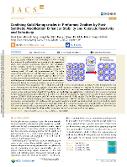| dc.contributor.author | Eom, Eunji | |
| dc.contributor.author | Song, Minseok | |
| dc.contributor.author | Kim, Jeong-Chul | |
| dc.contributor.author | Kwon, Dong-il | |
| dc.contributor.author | Rainer, Daniel Nikolaus | |
| dc.contributor.author | Gołąbek, Kinga Maria | |
| dc.contributor.author | Nam, Sung Chan | |
| dc.contributor.author | Ryoo, Ryong | |
| dc.contributor.author | Mazur, Michal | |
| dc.contributor.author | Jo, Changbum | |
| dc.date.accessioned | 2023-03-28T09:10:37Z | |
| dc.date.available | 2023-03-28T09:10:37Z | |
| dc.date.issued | 2022 | |
| dc.identifier.uri | https://hdl.handle.net/20.500.14178/1827 | |
| dc.description.abstract | Confining Au nanopartides (NPs) in a restricted space (e.g., zeolite micropores) is a promising way of overcoming their inherent thermal instability and susceptibility to aggregation, which limit catalytic applications. However, such approaches involve complex, multistep encapsulation processes. Here, we describe a successful strategy and its guiding principles for confining small (<2 nm) and monodisperse Au NPs within commercially available beta and MFI zeolites, which can oxidize CO at 40 °C and show size-selective catalysis. This protocol involves post-synthetic modification of the zeolite internal surface with thiol groups, which confines AuCl(x) species inside microporous frameworks during the activation process whereby Au precursors are converted into Au nanoparticles. The resulting beta and MFI zeolites contain uniformly dispersed Au NPs throughout the void space, indicating that the intrinsic stability of the framework promotes resistance to sintering. By contrast, in situ scanning transmission electron microscopy (STEM) studies evidenced that Au precursors in bare zeolites migrate from the matrix to the external surface during activation, thereby forming large and poorly dispersed agglomerates. Furthermore, the resistance of confined Au NPs against sintering is likely relevant to the intrinsic stability of the framework, supported by extended X-ray absorption fine structure (EXAFS), H(2) chemisorption, and CO Fourier transform infrared (FT-IR) studies. The Au NPs supported on commercial MFI maintain their uniform dispersity to a large extent after treatment at 700 °C that sinters Au dusters on mesoporous silicas or beta zeolites. Low-temperature CO oxidation and size-selective reactions highlight that most gold NPs are present inside the zeolite matrix with a diameter smaller than 2 nm. These findings illustrate how confinement favors small, uniquely stable, and monodisperse NPs, even for metals such as Au susceptible to duster growth under conditions often required for catalytic use. Moreover, this strategy may be readily adapted to other zeolite frameworks that can be functionalized by thiol groups. | en |
| dc.language.iso | en | |
| dc.relation.url | https://doi.org/10.1021/jacsau.2c00380 | |
| dc.rights | Creative Commons Uveďte původ-Neužívejte dílo komerčně-Nezpracovávejte 4.0 International | cs |
| dc.rights | Creative Commons Attribution-NonCommercial-NoDerivativeWorks 4.0 International | en |
| dc.title | Confining Gold Nanoparticles in Preformed Zeolites by Post-Synthetic Modification Enhances Stability and Catalytic Reactivity and Selectivity | en |
| dcterms.accessRights | openAccess | |
| dcterms.license | https://creativecommons.org/licenses/by-nc-nd/4.0/legalcode | |
| dc.date.updated | 2024-01-29T17:10:37Z | |
| dc.subject.keyword | supported catalyst | en |
| dc.subject.keyword | gold | en |
| dc.subject.keyword | zeolite | en |
| dc.subject.keyword | confinement | en |
| dc.subject.keyword | nanoparticles | en |
| dc.relation.fundingReference | info:eu-repo/grantAgreement/UK/PROGRES/Q46 | |
| dc.relation.fundingReference | info:eu-repo/grantAgreement/MSM/EF/EF15_003/0000417 | |
| dc.relation.fundingReference | info:eu-repo/grantAgreement/GA0/GX/GX19-27551X | |
| dc.relation.fundingReference | info:eu-repo/grantAgreement/UK/UNCE/SCI/UNCE/SCI/014 | |
| dc.date.embargoStartDate | 2024-01-29 | |
| dc.type.obd | 73 | |
| dc.type.version | info:eu-repo/semantics/publishedVersion | |
| dc.identifier.doi | 10.1021/jacsau.2c00380 | |
| dc.identifier.utWos | 000859201700001 | |
| dc.identifier.eidScopus | 2-s2.0-85139565401 | |
| dc.identifier.obd | 621316 | |
| dc.identifier.riv | RIV/00216208:11310/22:10453657 | |
| dc.identifier.pubmed | 36311841 | |
| dc.subject.rivPrimary | 10000::10400::10403 | |
| dcterms.isPartOf.name | JACS Au | |
| dcterms.isPartOf.issn | 2691-3704 | |
| dcterms.isPartOf.journalYear | 2022 | |
| dcterms.isPartOf.journalVolume | 2 | |
| dcterms.isPartOf.journalIssue | 10 | |
| uk.faculty.primaryId | 115 | |
| uk.faculty.primaryName | Přírodovědecká fakulta | cs |
| uk.faculty.primaryName | Faculty of Science | en |
| uk.department.primaryId | 1049 | |
| uk.department.primaryName | Katedra fyzikální a makromolekulární chemie | cs |
| uk.department.primaryName | Department of Physical and Macromolecular Chemistry | en |
| dc.description.pageRange | 2327-2338 | |
| dc.type.obdHierarchyCs | ČLÁNEK V ČASOPISU::článek v časopisu::původní článek | cs |
| dc.type.obdHierarchyEn | JOURNAL ARTICLE::journal article::original article | en |
| dc.type.obdHierarchyCode | 73::152::206 | en |
| uk.displayTitle | Confining Gold Nanoparticles in Preformed Zeolites by Post-Synthetic Modification Enhances Stability and Catalytic Reactivity and Selectivity | en |

